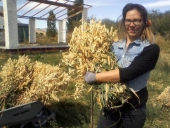




permaculture wiki: www.permies.com/permaculture








 2
2




permaculture wiki: www.permies.com/permaculture
 3
3




 1
1




Andre Wiederkehr wrote:Does anyone know more about how oats were traditionally processed and eaten?
Visit Redhawk's soil series: https://permies.com/wiki/redhawk-soil
How permies.com works: https://permies.com/wiki/34193/permies-works-links-threads

 4
4




Jay Angler wrote:Some reading I've done, suggests that traditionally, oats were grown and fed only to horses and not people.
When Dr Johnson defined oats as “a grain which in England is generally given to horses, but in Scotland supports the people,” his friend James Boswell replied, “that’s why England has such fine horses and Scotland such fine people.”

In modern mills, the first step of dehulling is a rotating disc that has numerous fins running from the centre of the disc to the exterior( Reference Girardet, Webster, Webster and Wood3 ). The oats fall into the centre of this rotating disc and are thrown into a series of impact rings on the wall of the dehuller, which causes the groat to be separated from the hull
Loosen the oat hulls in the oven if you plan to eat the oats. Roast the oats on a cookie sheet in an oven at 180 degrees for 90 minutes. The hull will puff up and begin to break away from the edible oat groat inside.
Use a burr mill or a roller mill to carefully grind the oat hull away from the groat. Collect everything, groat and hulls, into bushel baskets and cover with screening or mesh until you are ready to winnow.
Wait for a dry, breezy day to separate, or winnow, your oats and hulls. Spread out a sheet on a flat, dry ground. Bring out your bushel baskets.
Winnow the oats. Toss your hands full of the oats and chaff into the air. The breeze will carry away the hulls and the heavier grains will fall onto the sheet.
How Permies works: https://permies.com/wiki/34193/permies-works-links-threads
My projects on Skye: The tree field, Growing and landracing, perennial polycultures, "Don't dream it - be it! "
 2
2




Nancy Reading wrote: It seems that the Romans introduced oats here and they grow really well - better than alternative grains like wheat anyhow. They have been grown alongside rye and barley (also preferring the milder climate) for people food since then.
Visit Redhawk's soil series: https://permies.com/wiki/redhawk-soil
How permies.com works: https://permies.com/wiki/34193/permies-works-links-threads
















How Permies works: https://permies.com/wiki/34193/permies-works-links-threads
My projects on Skye: The tree field, Growing and landracing, perennial polycultures, "Don't dream it - be it! "




Nancy Reading wrote:Jay, If your summer is on the wetter side, then short season crops like rye, bere barley and oats are all worth a try.
Visit Redhawk's soil series: https://permies.com/wiki/redhawk-soil
How permies.com works: https://permies.com/wiki/34193/permies-works-links-threads
















How Permies works: https://permies.com/wiki/34193/permies-works-links-threads
My projects on Skye: The tree field, Growing and landracing, perennial polycultures, "Don't dream it - be it! "
 1
1




"You must be the change you want to see in the world." "First they ignore you, then they laugh at you, then they fight you, then you win." --Mahatma Gandhi
"Preach the Gospel always, and if necessary, use words." --Francis of Assisi.
"Family farms work when the whole family works the farm." -- Adam Klaus

|
After some pecan pie, you might want to cleanse your palate with this tiny ad:
montana community seeking 20 people who are gardeners or want to be gardeners
https://permies.com/t/359868/montana-community-seeking-people-gardeners
|



